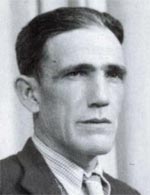Cipriano Mera facts for kids
Quick facts for kids
Cipriano Mera
|
|
|---|---|

Cipriano in 1940
|
|
| Birth name | Cipriano Mera Sanz |
| Nickname(s) | El Viejo (The Old Man) |
| Born | November 4, 1897 Madrid, Spain |
| Died | October 24, 1975 (aged 77) Saint-Cloud, France |
| Allegiance | |
| Service/ |
|
| Years of service | 1936–1939 |
| Rank | General |
| Commands held | Mera Column (1936) 14th Division (1937) IV Army Corps (1937–1939) |
| Battles/wars | Spanish Civil War
|
| Other work | Anarchist activist, Bricklayer |
Cipriano Mera Sanz (born November 4, 1897 – died October 24, 1975) was an important Spanish military and political figure. He lived during the time of the Second Spanish Republic.
Contents
Cipriano Mera's Early Life
Cipriano Mera was a bricklayer by trade. He had two sons, Floreal and Sergio, with his partner Teresa Gómez. He became involved in the anarchist movement. This movement believes in a society without a government, where people organize themselves freely. Mera led the construction workers' union in Madrid, which was part of the Confederación Nacional del Trabajo (CNT). This was a large union that supported anarchist ideas.
In June 1936, Mera led a big strike in Madrid. It involved construction workers, electricians, and elevator operators. Because of this strike, he was put in prison in early July.
Cipriano Mera in the Spanish Civil War
When the Spanish Civil War began, Cipriano Mera was released from prison. He quickly became a leader. He led a group of fighters called a "column." This column helped stop an uprising in several cities like Guadalajara, Alcalá de Henares, and Cuenca.
After that, he helped protect the dams of Lozoya. These dams supplied water to Madrid. He also fought in the mountains of Ávila and near the Tiétar river. Mera was given command of the 14th Division. This division played a key role in defending Madrid during the Siege of Madrid. They also fought in important battles like the Battle of Guadalajara in March 1937 and the battle of Brunete in July 1937. Later, he took command of the IV Army Corps. In April 1938, he was promoted to lieutenant colonel.
The War's End and Mera's Role
By 1939, Cipriano Mera believed that the side he was fighting for, the Republicans, would lose the war. The leader, Juan Negrín, did not want to surrender to Francisco Franco. Mera decided to support Segismundo Casado, who was a commander in the Spanish Republican Army. He also supported Julián Besteiro, a politician.
Together, they planned a "coup d'etat." This is a sudden takeover of power. Their goal was to create a new group called the National Defence Council. This group wanted to end the war and reduce the influence of the Communist Party. In March 1939, Mera's forces were very important. They helped Casado win control in Madrid against other Republican forces. This action helped speed up the end of the war.
Life After the War
After the war ended, Cipriano Mera went to Valencia. From there, he flew to Oran and then Casablanca. However, in February 1942, he was sent back to Spain. In 1943, he was sentenced to death. But this sentence was changed to 30 years in prison. He was set free in 1946.
In 1947, he moved to Paris, France. He worked as a bricklayer there, just like he did in his early life. He lived in France until he passed away in Saint-Cloud in 1975.
Films About Cipriano Mera
Cipriano Mera appeared as himself in a 1936 film called "Castilla Libertaria." In 2009, a documentary film was made about his life. It was called "Vivir de Pie. Las Guerras de Cipriano Mera" (Living on Your Feet: The Struggles of Cipriano Mera).
See also
 In Spanish: Cipriano Mera para niños
In Spanish: Cipriano Mera para niños

